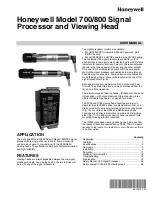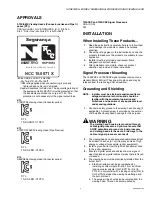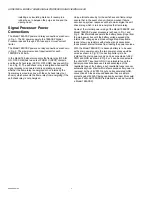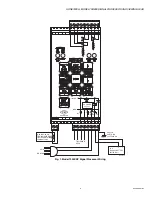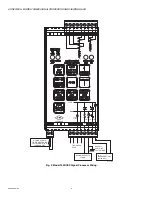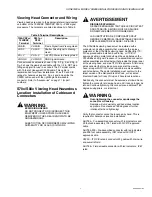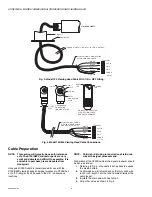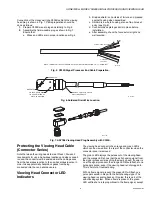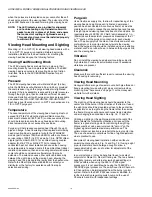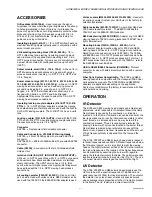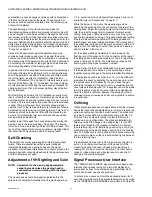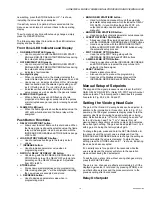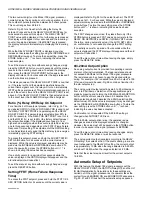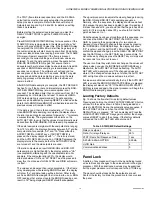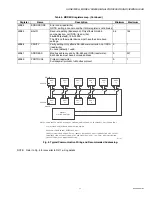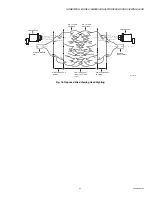
HONEYWELL MODEL 700/800 SIGNAL PROCESSOR AND VIEWING HEAD
66-2069EP—04
10
when the pulses are interrupted once per second for the self-
check pulse arrival at the viewing head. The pulse rate of the
green LED flashes can be used for aiming the viewing head.
NOTE: The LED indicators are provided for alignment
and troubleshooting only. Reinstall cover with
gasket correctly in place at all times, and ensure
that connector coupling is tightened securely.
This gasket and cover must be installed properly
to maintain IP67 rating.
Viewing Head Mounting and Sighting
Mounting is 1/2-in. NPT (F) for all viewing head models with a
1/4-in. NPT (F) purge air connection. Before beginning
installation, determine the best location for mounting the
viewing head based upon the following factors:
Viewing Head Mounting Block
The S70X viewing heads are held firmly in place in their
mounting blocks by two zinc-plated steel latches. The S80X
viewing head is secured in its mounting block by a friction
twist-lock. Refer to the ACCESSORIES section for part
numbers.
Pressure
The S70X viewing head lens will withstand 50 psi (3.4 bar)
while the S80X lens will withstand 90 psi (6.2 bar), provided
the compression ring on the purge air adapter is tightened
properly. If the lens assembly is exposed to greater pressures
through the sight pipe, then an isolation unit must be used.
Honeywell isolation units with purge air entrance are available
as accessories; ISO-UNIT, ISO-UNITSS, ISO-UNITHPGT.
Each has a quartz window, two 1-in. NPTF connections and a
1/2-in. NPTF purge port.
Temperature
The case temperature of the viewing head housing must not
exceed 185°F (85°C) while the standard Delrin mounting
block must not exceed 180°F (82°C) continuous service. Care
should be taken to ensure the case housing and mounting
block temperatures do not exceed these values.
Purge air will help reduce conducted heat through the sight
pipe and flange. A heat insulating Ultem replacement viewing
head mounting block is available for both the S70X/S80X
models (part numbers 700UA and 800UA) with a continuous
service rating of 320°F (160°C) as well a 1/2-in. NPTM Ultem
nipple (part number R-518-13) or an Ultem locking coupler
adapter (R-518-PT13 or R-518-PT13L) to reduce the
conducted heat, but direct radiation can cause the housing
case temperature to exceed limits. If the ambient heat (direct
radiation) is excessive, then an air cooling canister with vortex
cooler should be considered or alternately a fiber optic
extension. The extension uses a fiber optic cable assembly
between the sight pipe and the viewing head, allowing the
viewing head to be placed further away from the heat source.
Refer to the Fiber Optic Manual 69-2683 or contact your
distributor or the factory for assistance with fiber optic
selection and pricing.
Purge Air
Use a flexible air supply line, to allow for repositioning of the
viewing head and sight pipe until a final and permanent
position has been decided. A continuous flow of air must be
maintained in order to reduce the conducted heat and to keep
the sight pipe and viewing head lens free of dirt and debris. Air
required is about 5 SCFM (0.13 Nm3 /min) delivered at 1 in.
(25mm) above the maximum pressure as measured at the “Y”
or “T” section of the purge air connection for each viewing
head. The air supply must be clean, free of oils and water, and
preferably cool. In order to electrically isolate the viewing
head, the purge air line should be installed using an insulating
material, such as a rubber hose, in between the purge air line
and the viewing head.
Vibration
Do not install the viewing head where it could be subject to
high vibration. Provide an anti-vibration mount if excessive
vibrations are present.
Clearance
Make sure there will be sufficient room to remove the viewing
head housing for servicing.
Viewing Head Mounting
Honeywell offers a range of swivel mounts, both pipe thread or
flange mounting for use with sight pipes or direct wind box
mounting. See “Accessories” on page 11 or the Honeywell
website for further details.
Viewing Head Sighting
The sighting of the viewing head should be parallel to the
center line of the burner in the direction of the flame. If used,
the sight pipe should be mounted as close to the center line
as possible so as to sight along the flame rather than across
the flame. Doing so will ensure continuous flame detection
under changing load conditions. See Fig. 16, 17 and 18.
Utilizing a sighting or the sight pipe aimed at the root of the
flame (where the turbulent combustion air mixes with the
flame) is a good starting point for optimizing the sighting.
Where practical, using a swivel mount to “zero-in” on the
highest signal will assure maximum performance. The
optimum scanner location is parallel to the burner center line.
The use of a swivel mount allows for line of sight adjustment,
where practical to use.
Examples of viewing head installation with and without a
swivel mount are shown in Fig. 14 and Fig. 15. If using a sight
pipe, its diameter should be large enough to allow a
reasonable field of view, and to allow for adjustment of the
swivel mount angle.
In some instances, it may be beneficial to use two sets of
setpoints for Flame On, Flame Off and gain. The two-channel
capability (primary and alternate viewing head settings) is
ONLY possible when using the P531 or P532 signal
processors; it is not possible when using the 700ACSP or
700DCSP signal processors. The switch-over from Channel A
to Channel B can be implemented from the burner control
system. Refer to the P531/P532 user manual, 66-2068, for
further information regarding switch-over and the use of
Channels A and B with independent settings.

